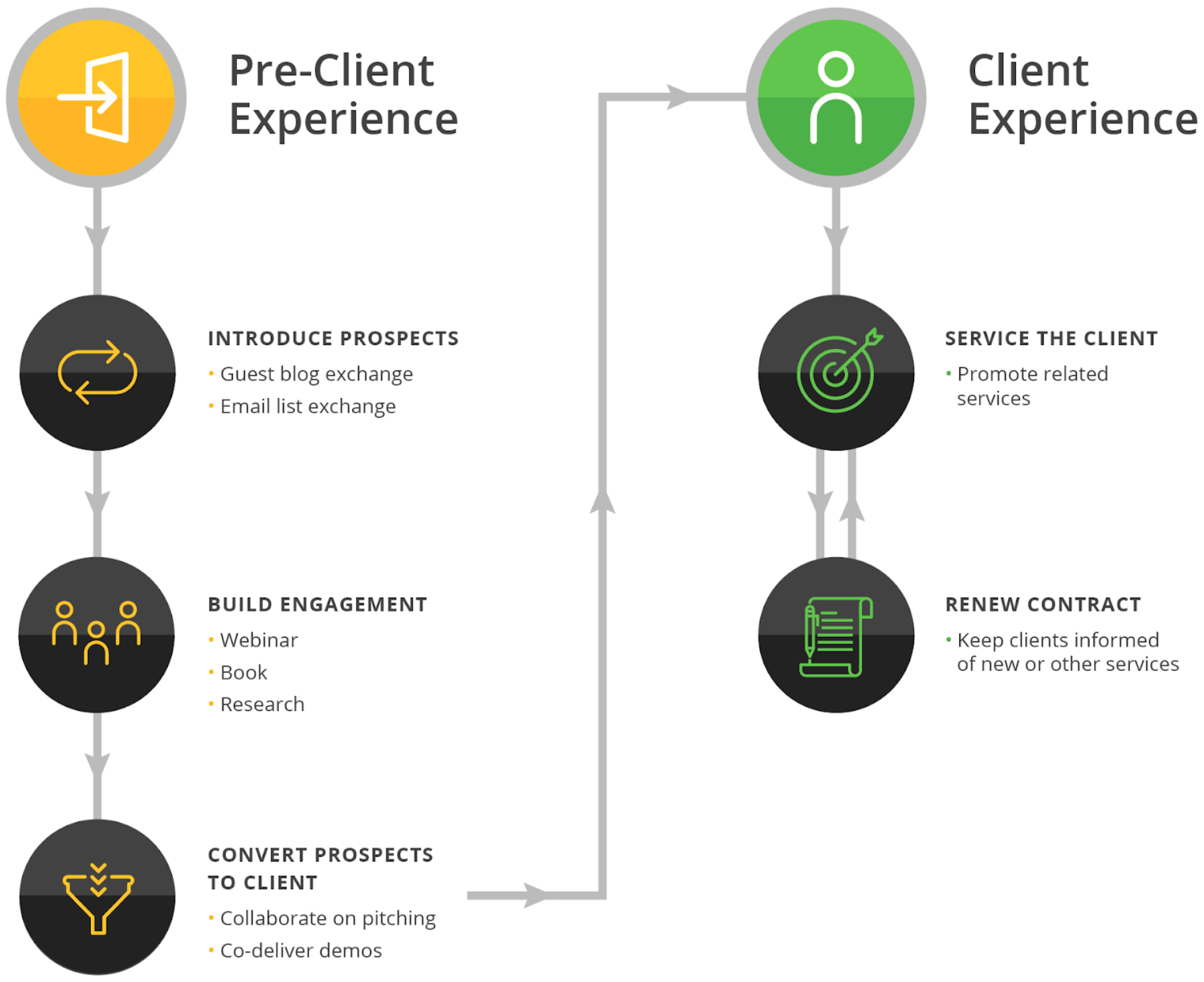If disruption is the new normal, strategic business partnerships are its antidote.
Strategic business partnerships are one of commercial history’s oldest strategies. Some say they even date back more than two millennia. Their relevance through the years endures because they help partners expand capabilities, exploit opportunities, reduce risk, or all three.
For professional services firms in today’s fast-changing, largely digital business environment, partnerships play a more crucial role than before: they help firms stay relevant and competitive in a crowded marketplace. It’s no wonder the Hinge Research Institute’s High Growth Study 2022 lists partnerships as one of the top 10 techniques firms use to promote their services.
What are strategic business partnerships?
A strategic business partnership is a relationship formed by two or more organizations whose goal is to create more value for target clients’ new or underserved needs. In doing so, it creates value for each partner firm. This goal is achieved by enhancing each firm’s access to information, resources, areas of expertise, and buyers.
In the professional services industry, strategic business partnerships can help firms close gaps in content and capability, amplifying each firm’s visibility—online and off—and expanding their expertise. Viewed from another angle, partnerships in professional services is a matter of lending and borrowing reputations and audiences.
But not all strategic business partnerships meet their goals. Success depends largely on finding the right partners, forging the right partnership, and promoting it.
Because partnerships can be lucrative, almost all firms engage in some form of partnership.
Most will promote their partnership by putting each other’s logos on their website. Many will deliver a pitch together. But few will collaborate on marketing and business development throughout the pre-client and client-experience stages. They operate as though the added value they’ve agreed to deliver didn’t exist or, worse, should remain an industry’s best-kept secret. This way of thinking undermines one of the main benefits of partnerships—enhanced audience reach and conversion.
What’s a good strategic business partner firm?
A good partner firm will have the following characteristics:
- Audience: Serves the same (or similar) audience you currently–or wish to–serve.
- Compatible areas of expertise: Offers a service or product that complements–rather than competes with—yours (examples: a business law firm and an accounting firm; an architecture firm and an engineering firm; a marketing firm and a sales training firm) and is interested in your offering.
- Reputation: Bolsters your credibility with an audience and raises no red flags when you do an online search, whether on the organization or any of its team members.
- Visibility: Has a sizable mailing list that only minimally overlaps with yours, a site whose domain authority is just as good if not better than your site’s, and as many or more followers on social media as you do. If you’ve published externally and spoken at industry events, try to find a partner who has done the same.
- Content Development: Frequently and consistently produces insightful, educational pieces in different formats—blog, video, infographics, etc.—that they distribute through integrated marketing communications campaigns (i.e., earned, owned, shared, and paid media).
- Commitment to reciprocity: Is comfortable sharing the stage (figuratively or literally) with you
- Clients: Will give you access to clients you don’t already have
These are the characteristics to look for. But, finding the right partner for your business demands a closer look at how partnerships fit into your business strategy.
How to find the right strategic business partner
The key to finding the right partner is to have clear objectives for the partnership. What do you want the partnership to help you achieve? Is it to reach a new audience? Extend your array of services to an existing audience?
Whether you’re addressing an existing audience or a new one, the partnership will, by design, have an impact on the buyer’s journey. The questions you need to ask are:
- Where in the buyer journey can the partner make an impact?
- What can the partner do to make the desired impact?
The professional service buyer journey has four stages:
- The Pre-Client Experience
- The Client Experience
- Between Engagements
- Former Client
Figure 1 shows some of the roles or responsibilities partners can play at each stage.

Figure 1: Buyer Journey: Partner Role and Responsibility Map
Some partners carry out roles and responsibilities limited to one stage. Others might stretch into the client experience stage and beyond.
Pre-client experience
In the pre-client experience stage partners can collaborate through joint promotion, each firm providing a warm introduction of the partner to their audience. The partnership’s success rests on how well the firms’ efforts move marketing qualified leads from the top to the bottom of the funnel.
If your partner’s role is to expose you to their audience, you might consider the following activities:
- Guest posting on each other’s blogs.
- Sending each other’s content to your own lists.
To build engagement you could:
- Co-promote and co-present at a webinar
- Conduct market research together
- Collaborate on a book
To convert prospects into clients:
- Submit a joint proposal to a shared prospect
- Co-deliver consultations or demos
Partnership marketing offers partners several key benefits. One, it allows them to fast-track building relationships with a new audience or expanding their reach into an existing audience. Two, it provides a forum for testing the partners’ compatibility before moving from joint promotion to service or product integration.
Client Experience, Between Engagements, and Former Client
When partnerships reach the client experience stage, enough trust and confidence have been built for partners to collaborate on offering a service to a single client. The success of this more complex, longer-term partnership hinges on effective, continual joint promotion and business development.
Continually promoting the partnership and each other’s service capabilities are key to winning more of a client’s business. Yet the 2020 Inside the Buyer’s Brain Study indicates that less than 40% of clients are aware of their professional services firms’ breadth of offerings. If partners don’t educate clients about their services, those clients will likely switch to competitors who do. Keeping your clients informed of your offerings at key points of the engagement reduces the risk of losing them. In many instances, the “former client” stage is avoidable, not inevitable.
Understanding what role potential partners will play is not enough. You’ll also need to consider what you bring to the table. Assuming your potential partners are also mapping out roles across the buyer journey map, think about what content and capabilities you can offer to close their gaps.
Where to find the right strategic business partners
Once you have a vision of how you and your partners can collaborate, you can start looking for prospects. A few good places to start are:
- Other Visible Experts or thought leaders
- Industry-specific LinkedIn groups
- Sponsors and speakers at industry conferences
- Members of industry associations
- Business journal lists
- Industry publications
- Google searches
How to probe for prospective partner information
Once you have a list of prospects, it’s time to do the research on each one. Start with their website. Next, sign up for their newsletters, attend their webinars, and follow them on social media. Then ask yourself:
- Do their services meet your clients’/audience’s needs without competing with yours?
- Do any of your services meet their clients’ needs?
- What new value proposition can you offer clients by joining forces?
- Do they develop high-quality educational content?
- How do they promote their services? Through what channels?
- Is their brand a good match for yours—ie, is their reputation, values, and style in sync with your firm’s?
- Do they partner with your competitors?
- Do they have an engaged audience on social media?
- Do they externally publish and speak at conferences?
It’s crucial to know whether prospective partners have the digital marketing chops, service capabilities, or both to help you reach your business goals.
Equipped with a shortlist, you can start reaching out.
Partner meeting agenda
Once you make contact and agree to meet, plan what you’ll cover in your conversation. Here are a few items to consider:
- Ways your firm could help theirs. Remember, this initial conversation has to be focused on what you can do for them. So come with several specific ideas in mind.
- Ask about their target audience (company sizes, demographics, job titles, etc.)
- Ask how they market to their prospects, and what they think their audience
needs most. (You will already have some idea of what their campaigns are like if you’ve signed up for their content, followed them on social media, etc.) - Ask how they’ve conducted joint promotions or joined-up services with partners before
- Ask how they usually measure success
No matter how thoroughly you vet your partner and negotiate your agreement with them, you won’t know if you’re compatible until you start collaborating. To ensure success, clarify the roles, goals, and measures of success to everyone.
Start with a small, discrete project, such as exchanging guest blog posts or hosting a joint webinar. Take a hard look at what results you produced together and what it was like to collaborate. Does it look like a good fit? Would you want to move forward with more joint promotions? Was it so good that you’re considering going beyond the pre-client experience?
However, if the results fall below your targets and the collaboration is difficult, be willing to walk away. Not every partnership will end up meeting expectations. When it doesn’t work out, it’s in both parties’ interest to move on.
But don’t burn bridges unless the experience was abysmal. Sometimes, partnerships are a matter of timing. You just might need that firm’s help down the road—and vice versa.




